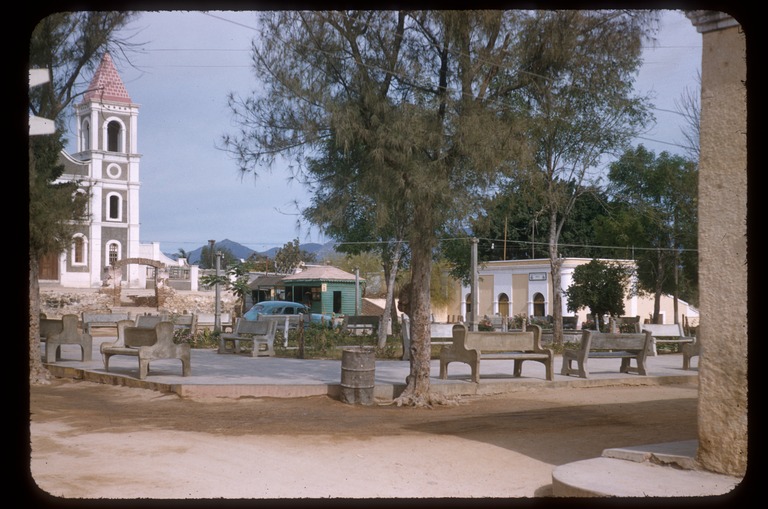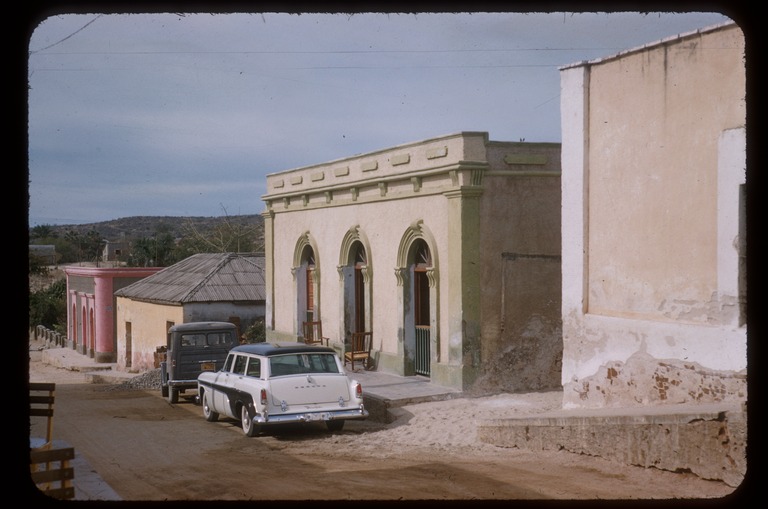All photos by Howard E. Gulick, from the Baja California Collection of the University of California San Diego.
In the aftermath of the Mexican Revolution, cape communities San José del Cabo and Cabo San Lucas settled into a period of relative calm and stability for the next half-century. Although the region would continue to experience the vicissitudes associated with commercial endeavors such as ranching, farming and fishing, its fundamental character would remain essentially unchanged until the age of tourism.
It was a welcome interlude. Both communities had suffered through a difficult drought period prior to the Mexican Revolution. So difficult were the last five years of the 19th century, in fact, that a significant portion of the residents left, many to work in the hellish Rothschild owned El Boleo copper mines in Santa Rosalía. At the advent of the Revolution in 1910, San José del Cabo had a population of 4,300 people, down over 18% from the previous decade. However, since the total population of what is today Baja California Sur amounted to only about 42,500 inhabitants, San José still maintained a robust 10% of the territorial population.


By the early 1920s, San José had not only recovered from the devastating drought years, but was experiencing unheard of levels of prosperity. “In 1924,” observed Alba E. Gámez in her historical account of the area, “the production of the planting and cultivation of sugar cane was processed in 41 mills and up to 690 tons of piloncillo (unrefined whole cane sugar) were produced for export.
Furthermore, 90 tons of tomatoes were harvested. On a smaller scale, mango, avocado, citrus fruits, oregano, and damiana, a native shrub used for medicinal purposes and flavoring liqueur were produced. Parallel to the agricultural prosperity, cattle herds that year totaled more than 24,000 head of cattle.”

This prosperity translated to increased infrastructure and upgrades in public education, as well as the tangible symbols of 20th century modernization. The first road between the San José and San Lucas was established in 1926, with horses increasingly joined by cars on the dirt thoroughfare. The first automobile agency, a Ford dealership, opened in San José in 1930. The following year the first airplane ever seen in the area appeared in the skies over San José.
The plane was piloted by a military aviator named Captain Feliciano “El Piojo” Flores. A veteran of the Mexico City airshow of 1930, Flores thrilled the Josefinos with an arsenal of maneuvers that included dives, somersaults and stalls. When the diminutive Mazatlán native finally landed, he was fêted like a conquering hero, and a dance was immediately organized in his honor (an episode remembered in C.M. Mayo’s superb 2002 travelogue Miraculous Air.).
In Cabo San Lucas, which lacked the fertile soil and abundant water resources of San José del Cabo, the late 19th century drought had also hit hard. Over 1,200 head of cattle were lost between 1895 and 1901, and the already limited planting area decreased by 72% in the space of a single year (1900 t0 1901). Luckily for the beleaguered Sanluqeños, a new commercial enterprise was looming on the horizon.
From 1913, the year the first cannery ship was stationed in Cabo San Lucas Bay, until the 1970s, when tourism became the primary income generator, Cabo San Lucas was first and foremost a commercial fishing town.
By 1917, cannery operations consisted of a four-masted sailing ship anchored near Land’s End, where it was serviced by a fleet of small skiffs and jig boats. The golden age, however, began in 1925 when brothers Carlos and Luis Bernstein Riverol capitalized the Compañia de Productos Marinos with 100,000 pesos, registering the name in Tijuana, and dividing the business into 50,000 shares which sold for the princely sum of two pesos apiece.


Productos Marinos brought in a larger factory ship, which processed and canned seafood caught by four wooden hulled auxiliary vessels, each with a storage hold, but with no cooling capacity. These fishing boats were manned by men from all over the world; men from Italy, Portugal, Yugoslavia and the U.S. Only a few dozen families lived in Cabo San Lucas at this time, and locals were primarily engaged aboard the mother ship, where they gutted, sterilized and canned the catch for export.
A land-based cannery began to be built on Playa Coral Negro in 1927, with operations kicked into overdrive in 1928 after the cooling system caught fire on the factory ship, causing it to sink. The permanent cannery opened in 1929, and over the course of coming decades became the most productive in Latin America, and one of the most productive in the world, accounting at its peak for some 75% of the canned seafood produced in México.
Tuna, first canned in oil in 1930, was by far the most lucrative fish. Productos Marinos eventually employed three fishing ships – the Cabo San Lucas, Cabo Tosca and Punta Redondo – each capable of carrying tons of seafood to the cannery, where it was processed by a crew of around 50 people. Manuel Sarriz was the first manager, and the first man in Cabo San Lucas to buy a car, which he of course acquired from the Ford agency in San José del Cabo.
John Heston took over as manager in 1935, the year the workers decided to unionize, forming what would become the Sindicato de Trabajadores Evolutivos, Estibadores y Pescadores in 1938; when, on the advice of CROM, the Regional Confederation of Mexican Workers, they split into three factions.

Cabo San Lucas thus became a company town, with one major industry, and a factory whistle that blew daily at 7 a.m., noon, and 1 and 4 p.m.: indicating the start of business, lunch hours, and closing time, respectively.
Elías Pando bought the company in 1948, ushering in a new era with the area’s first dedicated tuna fleet. He acquired some 11 American boats for that purpose, each capable of carrying around 40 tons. That was only the beginning. At the height of its powers, Impresas Pando employed a 1,000-ton ship called the Calmex.
Fishing was not Pando’s only investment, however. He was a businessman with wide interests, diversifying his money in chocolate, perfumes, wines and soap, among other products. Originally born in El Carmen, a small community in the municipality of Ribadesella in northwestern Spain, Pando’s most important move may have been hiring another man from Ribadesella as manager.
“I moved to Cabo with my wife in 1954,” remembered Don Luis Bulnes Molleda in a 1992 interview for Baja Explorer. “We had no children in those days. It was impossible to have children here. No doctors, no medicine, no nothing. It was really isolated. To take a trip to La Paz took five or six hours by car. In the stormy season it could take a week because the road would wash out. Once I had to rebuild the road with my guys. We were isolated for 25 days.”
When Bulnes and his wife Conchita arrived in Cabo San Lucas, the population of the town had grown to about 300 people. Twenty-five years later, in March 1979, when the cannery released its last 300 workers, Bulnes’ Hotel Solmar had been open for five years, and the age of tourism was transforming the region soon to be known as Los Cabos.
Want your business, activity or event featured and promoted by CaboViVO, please be sure to contact us here, thanks…
Saludos from Co-Founders…
Chris Sands – Writer and Michael Mattos

